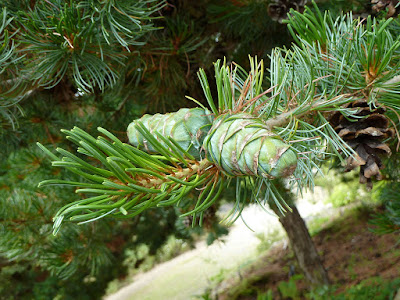Pinus parviflora is found in Japan (Honshu, Kyushu, Shikoku, Hokkaido)and Republic of Korea. It occurs at altitudes from just above sea level to about 2500 m, with an optimum between 1000 and 1500 m in montane forests. It is hardy to USDA Hardiness Zone 4B through 7A.
Pinus parviflora also called as five-needle pine, Ulleungdo white pine, Japanese white pine, is a species of the genus Pinus. This species was described by Philipp Franz von Siebold & Joseph Gerhard Zuccarini in 1842.
IDENTIFY PINUS PARVIFLORA - JAPANESE WHITE PINE PLANTS
Pinus parviflora is found in Japan (Honshu, Kyushu, Shikoku, Hokkaido)and Republic of Korea. It occurs at altitudes from just above sea level to about 2500 m, with an optimum between 1000 and 1500 m in montane forests. It is found in both pure and mixed stands with other conifers and also with angiosperms, usually on steep slopes, dry sites or rocky ridges. At high, subalpine habitats this species becomes dwarfed and some of the cultivated forms may have been derived from such provenances. It is hardy to USDA Hardiness Zone 4B through 7A.
Japanese white pine is a coniferous evergreen tree, which growing up to 25 m in height with pale gray, aging dull gray, smooth when young, furrowed with age into scaly plates bark and is usually as broad as it is tall, forming a wide, dense, conical crown. The leaves are needle-like (filiform), blue or blue-green, green, in bundles of five, with a length of 5-6 cm. The cones are 4-7 cm long, with broad, rounded scales; the seeds are 8–11 mm long, nearly brown, mottled with black, irregularly obovoid with a vestigial 2–10 mm wing.
Some cultivars: Pinus parviflora ‘Brevifolia’ (upright, narrow tree, sparsely branched, blue/green foliage in tight bundles); Pinus parviflora ‘Glauca’ (greenish foliage with a touch of silver, wide-spreading tree, 45 feet high or more). The cultivars 'Adcock's Dwarf' and ‘Bonnie Bergman’ have gained the Royal Horticultural Society's Award of Garden Merit.
Ulleungdo white pine has great value as an ornamental. In Japan, this species has been in cultivation in gardens and parks and in temple grounds for many centuries. Growth forms that stay low and form picturesque shapes are highly sought after and these preferences culminate in the art of bonsai, for which this is the most commonly used species of pine.
PINUS PARVIFLORA - JAPANESE WHITE PINE PLANTS CARE AND CULTIVATION
The cultivation of these plants presents no special difficulties, if proper soil and exposure are available. The question of hardiness is, of course, all-important. It is not only the problem of temperature the given tree will stand, but also the exposure to winds, and, to a considerable extent, the source from which the tree is derived. If the plants are raised from seeds matured in similar or even more rigorous climates, they are usually more hardy.
Soils:
Pinus parviflora prefer a well-drained porous gravelly subsoil, overlaid with a light sandy loam. They seem to be particularly happy in a soil underlaid with a porous glacial drift. In cultivation, however, they succeed very well in ordinary well-drained soil. When the plants are set in clay soil, which is often done, the soil should be thoroughly loosened by trenching or subsoil plowing, and well under drained. Any available humus, wood ashes, and well-rotted manure incorporated in the soil greatly aid in rendering it friable and porous for the roots.
Manures and mulches:
Mulching with ordinary well-rotted barnyard manure in late autumn affords much stimulus to growth. By the following spring the manure will be in a desiccated condition and can be incorporated with the soil. A heavy mulch of old straw, rotten hay, or any similar material over the roots, and this was maintained throughout the entire growing season is benefit to the plants in a more or less juvenile condition.
In many cases manure is not obtainable. In such event, newly moved plants should be heavily mulched with rotten straw, rotten hay, or any similar rubbish for a few years until they become established. The frequent stirring of the ground over the roots subsequently will conserve sufficient moisture.
An area extending from the stem to one to two feet beyond the branches, stirred up with hoe and rake perhaps five or six times throughout the growing season, is very beneficial in conserving the moisture around the roots.
Pruning:
Removal of the lower branches of Japanese white pine is a serious mistake, and, if healthy, they should be retained to the base. Pruning or disbudding can be intelligently performed to add much to the natural symmetry. The extraction or removal, early in spring, of the central or terminal bud, will tend to compel the branches which start from the side buds to spread apart and form a much denser growth. Cutting back the previous year's terminal growth to a strong bud or branchlet on the main limbs over the tree, if the plant is inclined to be thin in its branching, always produces a much denser lateral growth.
Transplanting:
Transplanting can be done at all times of the year, excepting midsummer when they are in full growth. The best success is secured in spring when the buds begin to swell. From the end of August to the middle of September, if there have been abundant rains and the ground has been well soaked, is a very good time to move the plants. They may be planted late in autumn when circumstances compel it, but there is likely to be a considerable percentage of loss. Their roots are very susceptible to injury from exposure to the air, and the utmost vigilance should be exercised to keep them covered and moist.

















COMMENTS